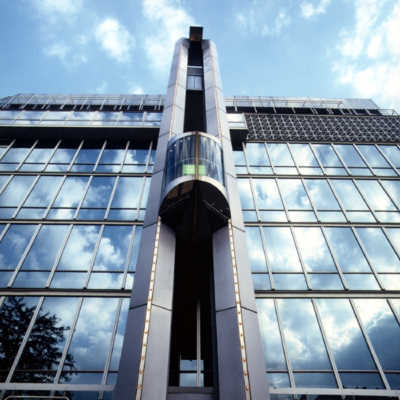This
ambitious project targeted to develop and validate a
commercially feasible active suspension system for
high-rise high-speed elevators capable of active
vibrations damping as well as position control of
the elevator car relative to the guide rails during
travel.
The
developed system is composed of 8 linear motors, 6
accelerometers, 8 position sensors, a signal
conditioning unit and the relevant power
electronics, with the whole system controlled by a
real-time computer equipped with the required
interfaces.
The
following are the different systems engineering
tasks that were accomplished through the successful
system development:
-
Setting the specifications for the sensors, the
actuators and the remaining subsystems, such as
the signal conditioning unit, based on the
results of the corresponding modeling and
simulation runs.
-
Selection of the sensors and cooperation with
the producers of the linear motors in order to
dimension, construct and test the selected
actuators
-
Evaluation and procurement of the real-time
computer system, which is used for the system
identification and system control.
-
Total system integration and testing.
-
Project management including the planning and
budgeting as well as the reporting and
presentation to the client.
Parallel to the system engineering the following
system dynamic analysis and controller synthesis
jobs were accomplished:
-
Development of a Multi-Input Multi-Output (MIMO)
system identification procedure in the frequency
domain, in order to obtain a linear time
invariant system model with 6 input signals and
12 output signals. The model considers all
couplings between the degrees of freedom of the
system and is used in the controller design.
-
Development of a controller synthesis procedure
to be realized in two main steps. In the first
step the closed loop employing the feedback of
the acceleration measurement is designed in
order to actively damp the vibrations. As the
asymmetric loading of the cabin will badly
influence the orientation of the elevator car
relative to the guide rails and one or more
actuator may touch their stoppers and hence
become disabled, the orientation of the elevator
car within the guide rails must be corrected
with the help of the a second closed loop
employing the feedback of the position
measurements. To optimize the performance of
both control loops the effectiveness of the
acceleration feedback loop is limited to the
frequency range in which humans are sensitive to
vibrations, which starts at 0.5 Hz. Accordingly,
the bandwidth of the position feedback loop will
be set to a frequency slightly less than this
frequency. The most suitable controller
synthesis method for the design of both feedback
control loops was found to be the H-infinity
MIMO design method.
-
Since the elevator will exist as a system after
its installation, the above-described procedure
must be able to be conducted on site and needs
to be simplified, so that the available
commissioning personnel may be trained to
accomplish it.
Active Ride Control is currently a commercialized
industrial system within the sales program of a
major world elevator producer.
For a dedicated presentation on the subject please
contact us.
